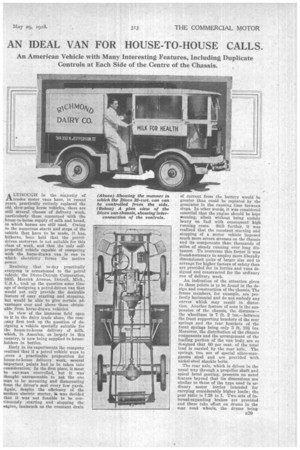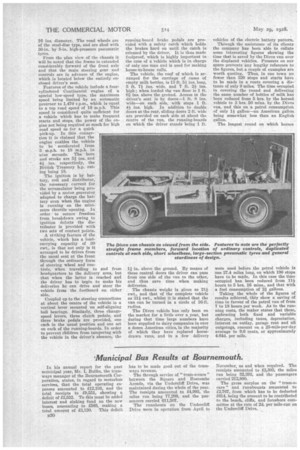AN IDEAL VAN FOR HOUSE-TO-HOUSE CALLS.
Page 47

Page 48

If you've noticed an error in this article please click here to report it so we can fix it.
An American Vehicle with Many Interesting Features, Including Duplicate Controls at Each Side of the Centre of the Chassis.
ALTHOUGH in the majority of trades motor vans have, in recent years, practically entirely replaced the old, slow-going horse vehicles, there are still several classes of delivery work, particularly those concerned with the house-to-house supply of milk and bread, in which horses are still used. Owing to the numerous starts and stops of the vehicle that have to be made, it has, hitherto, been held that the petroldriven motorvan is not suitable for this class of work, and that the only selfpropelled vehicle capable of competing with the horse-drawn van is one in which electricity forms the motive power.
Realizing that to-day practically everyone is accustomed to the petrol vehicle, the Divco-Detroit Corporation, 2435, Merrick Avenue, Detroit, Mich., U.S.A., took up the question some time ago of designing a petrol-driven van that would not only provide the desirable feature of easy starting and stopping, but would be able to give certain advantages over and above those obtainable from horse-drawn vehicles.
In view of the immense field open to it in the dairy trade alone, the company first took up the question of designing a vehicle specially suitable for the house-to-house delivery of milk, which, in America, as largely in this country, is now being supplied to householders in bottles.
Early in its experiments the company realized that if a petrol vehicle were to prove a practicable proposition for house-to-house delivery work, several important points had to be taken into consideration In the first place, it must be one-man controlled, but it was thought unreasonable to ask the one man to be mounting and dismounting from the driver's seat every few yards. Again, despite the efficiency of the modern electric starter, i4 was decided that it was not feasible to be continuously , starting and stopping the engine, inasmuch as the constant drain of current from the battery would' be greater than could be replaced by the generator in the running time between stops. In other words, it was considered essential that the engine should be kept manning, albeit without being unduly heavy on fuel with consequent high running costs. Still further, it was realized that the constant starting and stopping of a motor vehicle imposed much more severe stresses on the chassis and its components than thousands of miles of steady running over long distances. To overcome this factor it was found-necessary to employ more liberally dimensioned units of larger size and to arrange for higher factors of safety than are provided for in lorries and vans designed and constructed for the ordinary run of delivery Work.
An indication of the attention given to these points is to be found in the design and construction of the chassis. The frame members, for example, are perfectly horizontal and do not embody any curves which may result in distortion. Another feature of note is the suspension of the chassis, the distance— the wheelbase is 7 ft. 2 ins.—between the front supporting brackets of the rear springs and the rear brackets of the front springs being only 3 ft. 10i ins. Moreover, the distribution of the chassis components and the arrangement of the loading portion of the van body are so designed that 60 per cent, of the total load is carried, by the rear axle. The springs, too, are of special silica-manganese steel and are provided with nickel-steel shackle bolts.
The rear axle, which is driven in the usual way through a propeller shaft and spiral bevel. gearing, presents no novel feature beyond that its dimensions are similar to those of the type used in ordinary motor lorries intended for carrying considerably higher loads; the gear ratio is 7.28 to 1. Two sets of internal-expanding brakes are provided and these take effect on drums in the rear road wheel; the drums being
16 ins. diameter. The road wheels are of the steel-disc type, and are shod with _ 30-in. by 5-in, high-pressure pneumatic tyres.
From the plan view of the chassis it will be noted that the frame is extended considerably forward of the front axle and that the main steering gear and controls are in advance of the engine, which is located below the entirely enclosed driver's seat.
Features of the vehicle include a fourcylindered Continental engine of a special low-speed type, the maximum speed being limited by an automatic governor to 1,470 r.p.m., which is equal to a top road speed of 18 m.p.h. This speed is considered quite sufficient for a vehicle which has to make frequent starts and stops, the power of the engine not being required so much for high road speed as for a quick pick-up. In this connection it is claimed that the engine enables the vehicle to be accelerated from 3 m.p.h. to 18 m.p.h. in nine seconds. The bore and stroke are 8 ins. and 41ins, respectively, the
British Treasury rating being 18.
The ignition is by battery, coil and distributor, the necessary current for the accumulator being provided by a motor, generator adapted to charge the battery even when the engine is running on the minimum throttle opening. In order to secure freedom from breakdown owing to ignition defects the distributor is provided with two sets of contact points.
A striking feature of the vehicle, which has a loadcarrying capacity of 30 cwt., is that not only is it arranged to be driven from the usual seat at the front through the ordinary form of steering wheel and controls, when travelling to and from headquarters to the delivery area, but that when the latter is , reached and the driver has to begin to make his deliveries he can drive and steer the vehicle frora the footboard on either side.
Coupled up to the steering connections at about the centre of the vehicle is a vertical lever mounted on self-aligning ball bearings., Similarly, three changespeed levers, three clutch pedals, and three brake pedals are provided, one each in the usual position and one set on each of the running-boards. In order to prevent children from tampering with the vehicle in the driver's absence, the
running-board brake pedals are provided with a safety catch which holds the brakes hard on until the catch is released by the driver. It is thus made foolproof, which is highly important in the case of a vehicle which is in charge of only one man and is used for making house-to-house calls.
The vehicle, the roof of which is arranged for the carriage of eases of empty milk bottles, is 13 ft. 5i ins. long, 5 ft. 71 ins, wide, and 7 ft. 2-i ins. high ; when loaded the van floor is 1 ft. fit ins, above the ground. Access to the driver's seat is by doors-1 ft. 8 ins. wide—on each side, with steps 1 ft. 41, ins. high. In addition to double doors at the rear, sliding doors 2 ft. wide are provided on each side at about the centre of the van, the running-boards on which the driver stands being 1 ft.
11 in. above the ground. By means of these central doors the driver can pass from one side of the van to the other, and thus save time when making deliveries.
The chassis weight is given as 21i cwt., and that of the complete vehicle as 31t cwt., whilst it is stated that the van can be turned in a circle of 16-ft. radius.
The Dive° vehicle has only been on the market for a little over a year, but during that time large numbers have been supplied to dairy companies in over a dozen American cities, in the majority of which they have replaced horsedrawn vans, and in a few delivery vehicles of the electric battery pattern.
Through the assistance of its clients the company has been able to collate some interesting figures showing the time that is saved by the Divco van over the displaced vehicles. Pressure on our space prevents any lengthy reference to the figures, but a couple of examples are worth quoting. Thus, in one town no. fewer than 320 stops and starts have to be made in a route covering a distance of only 9 miles. The time occupied in covering the round and delivering the same number of bottles of milk has been reduced from 5 hrs. by the horsed vehicle to 3 hrs. 50 mins. by the Divco van, and this on a petrol consumption of only lj gallon—an American gallon being somewhat less than an English gallon.
The longest round on which horses
were used before the petrol vehicle is one 27.4 miles long, on which 190 stops have to be made. In this case the time occupied has been reduced from 11i hours to 5 hrs. 16 min,s., and that with a fuel consumption of 2.1 gallons.
Taking the whole of the figures of results achieved, they show a saving of time in favour of the petrol van of from 7 to 18 hours per week. As to the running costs, the maker states that these, embracing both fixed and variable charges, including taxes, depreciation, interest on outlay, garage rent and all outgoings, amount on a 25-mile-per-day average to 9.6 cents, or approximately 4.64d. per mile.




































































































